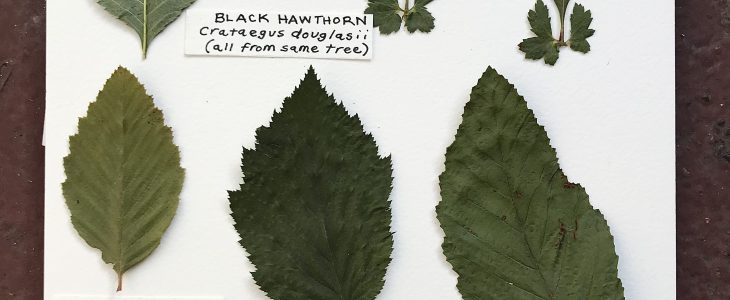
As an herbalist, one of my favorite fall traditions is harvesting hawthorn berries. Harvest or not, I adore the beauty of bare-limbed hawthorns laden with red/black berries against the matte grey sky or dusk of crisp fall evenings.
Black hawthorn is a small, deciduous tree/shrub of the Rose Family (Rosaceae). Hawthorns have an attractive architecture, akin to hazelnut or mountain mahogany. The berries are clusters of pomes, which ripen red, or in the case of Crataegus douglasii: dark black. The berries are a marriage between a semi-sweet crab apple and a rose hip. Hawthorn flowers are panicles of white, cupped 5 petaled florets, with yellow stamens and anthers, similar in shape to wild rose.
Black hawthorns (and hawthorn’s in general) are more abundant in the Pacific Northwest, but their range extends south along Northern California’s coastal mountain range to Sonoma country, across the Siskiyou/Trinity complex and into the Sierra Foothills. They can be found in wet places following mountain streams and rivers, perched a step or two up the bank. Look for them among other riparian vegetation including creek dogwood, serviceberry and Western chokecherry, a stone’s throw from pools with umbrella plant, and mossy rocks with stonecrops and littleleaf blink.
The berries and shrubby/thorniness of black hawthorn makes it a favorite browse and perch of birds, and is a host for as many as 36 species of butterflies and moths. They are a larval host to the gray hairstreak mourning cloak, pale tiger swallowtail and western tiger swallowtail.
All hawthorns hybridize easily with each other, especially the non-native common or English hawthorn. In seasons when flowers and berries have dropped, identification can be a maddening affair. Leaf shape within a specific species can be highly variable across stands, even on the same tree. Look for the tell tale sinus ‘hip’ a third of the way up the leaf from the stem. Look for the thorns!
Hawthorn is an important medicinal staple for herbalists and the home apothecarist. Hawthorn is an effective and safe heart and cardiovascular system tonic. It can help increase blood supply to the heart, oxygenate/modulate heart muscles, reduce heartbeat irregularity (arrhythmia, tachycardia), and help prevent and break down plaque (think arteriosclerosis). Hawthorn can help lower high blood pressure, is a helpful adjunct therapy for ADHD, and is a great preventative when heart disease runs in the family. The berries are rich in anti-inflammatory bioflavonoids. Hawthorn is not appropriate for Bradycardia (slow heartbeat) or with beta/calcium blockers.
Harvest the twig tip (leaf and flower) in spring. Harvest the ripe berries from October/January before the first frost. Combine all into equal parts for best medicinal value. Prepare fresh or dry, in teas, tinctures, glycerides or syrups. To beat winter grief and blues, try a tea of equal parts tulsi, skullcap, hawthorn leaf/berry/ flower mix, and rose petals.
We think it’s important to grow your own hawthorns at home, so that we don’t negatively impact wild lands and plant communities by wild-crafting or wild-taking. In the garden, black hawthorn can take poorly drained soil and is best with part to full sun, and moderate water. In addition to its medicinal and habitat value, it can be used for erosion control or pruned as a specimen tree for fall foliage or even pruned as a loose hedge or screen.
-Violet Thorns
Witchcraftapothecary.com
@Witchcraft_apothecary
1.The statements herein have not been evaluated by the Food and Drug Administration. The statements herein are not intended to diagnose, treat, cure, or prevent any disease.
2.Karyn Sanders and Sarah Holmes of The Blue Otter School of Herbal Medicine, and KPFA’s broadcast The Herbal Highway (blueotterschool.com / kpfa.org/program/the-herbal-highway)
3.Stascha Stahl, Clinical Western Herbalist (bayherbalist.com)
4.Herbal Therapy and Supplements, a Scientific and Traditional Approach, 2nd Edition, Merrily A. Kuhn & David Winston. 2008, Wolters Kluwar Health / Lippincott Williams & Wilkins
5. Medicinal Plants of the Pacific West, Michael Moore. 1993, Santa Fe Press. and Medicinal Plants of the Mountain West, Michael Moore. 2003, Museum of New Mexico Press, Santa Fe.